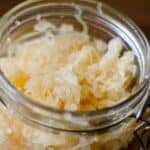Paleo Sauerkraut
Sauerkraut is more than just an accompaniment to bratwurst. It's a culinary adventure rooted in tradition and packed with nutrition.
Servings 128 people
Calories 7kcal
Cost $8
Equipment
- 1 Fermentation Jar
Ingredients
- 4 or 5 heads of red or green cabbage shredded
- ¼ cup sea salt
Instructions
- Place the shredded cabbage little by little in your fermentation jar, pounding them vigorously and sprinkling some of the sea salt as you go.4 or 5 heads of red or green cabbage, ¼ cup sea salt
- Make sure the mixture fills the jar up to 1 inch bellow the top (because of the expansion), adding more if needed, and that the extracted water covers the vegetables entirely. If not, create a brine of 2 tablespoons sea salt to 4 cups water and add it to the cabbage.
- Press the vegetables and keep them under the brine by placing a plate or a lid on top weighted down by a rock or a jug of water. Cover with a clean towel if needed to keep out fruit flies.
- Place the fermentation jar in a warm spot in your kitchen and allow the Sauerkraut to ferment for 7 to 10 days.
- Check on it from time to time to be sure that the brine covers the vegetables and to remove any mold that may form on the surface.
- A good way to know when it’s ready is to taste it during the fermentation process and move it to the refrigerator when you’re satisfied with the taste.
Nutrition
Calories: 7kcal | Carbohydrates: 2g | Protein: 0.4g | Fat: 0.03g | Saturated Fat: 0.01g | Polyunsaturated Fat: 0.005g | Monounsaturated Fat: 0.005g | Sodium: 226mg | Potassium: 48mg | Fiber: 1g | Sugar: 1g | Vitamin A: 28IU | Vitamin C: 10mg | Calcium: 11mg | Iron: 0.1mg
